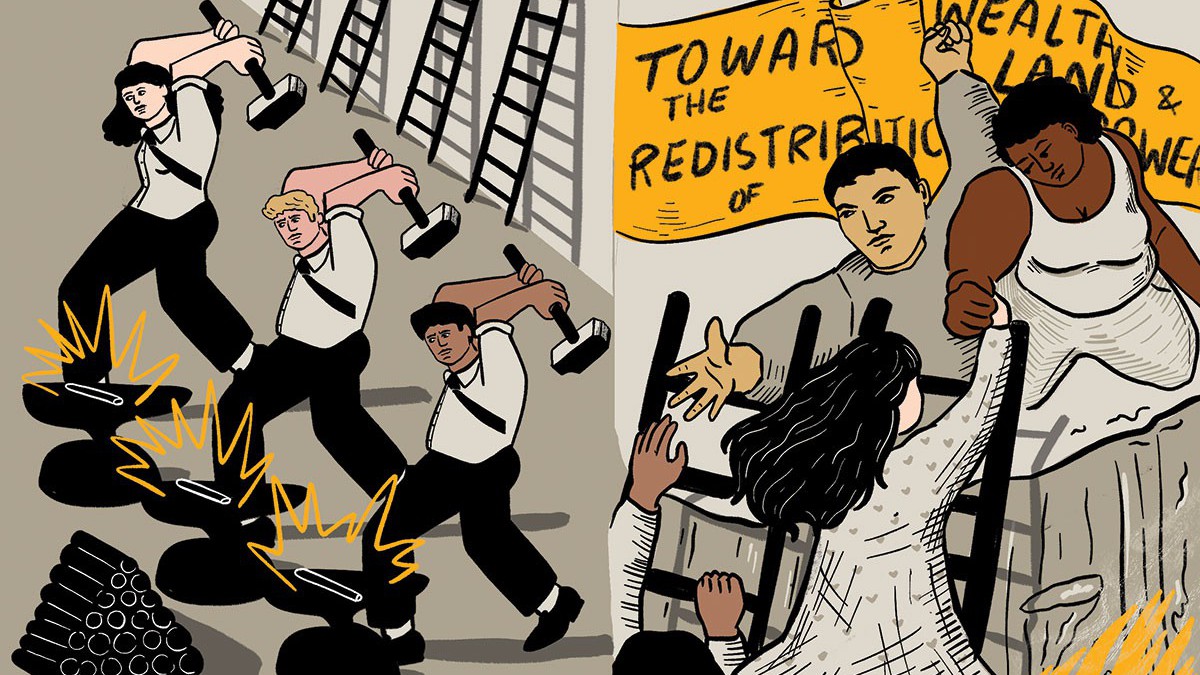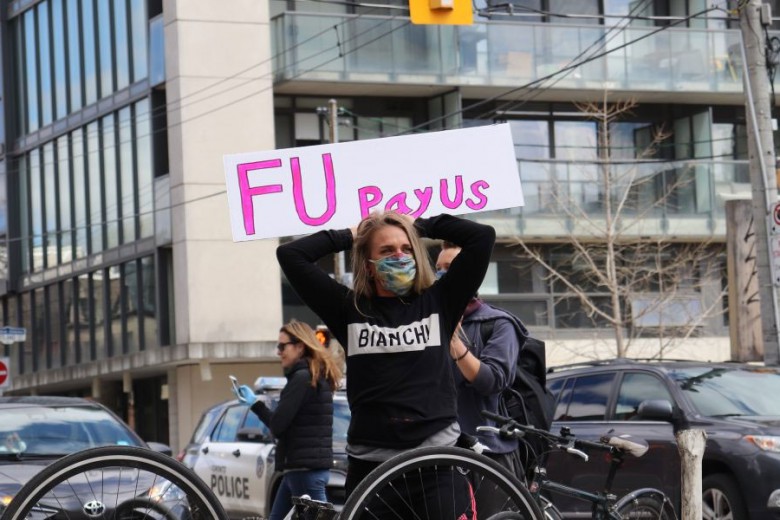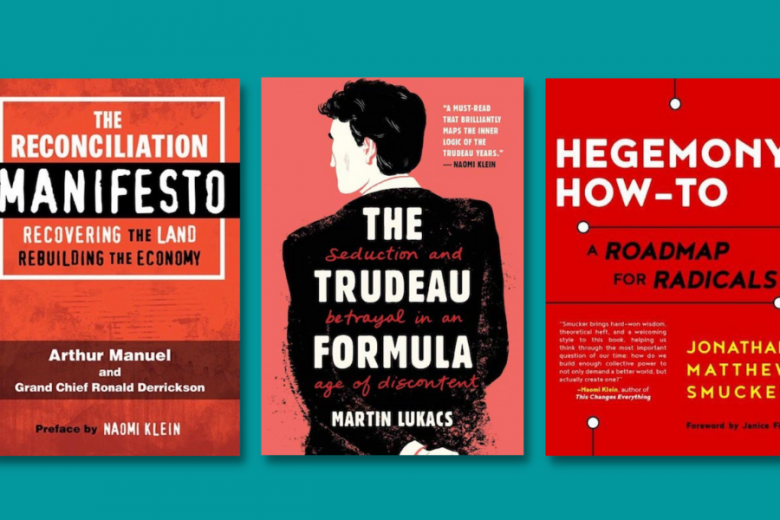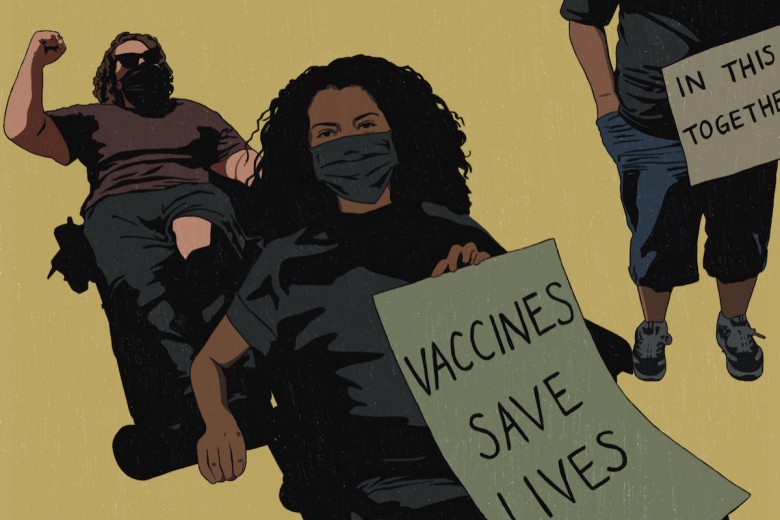At a party last spring in Montreal, a working-class friend of mine remarked, “How are organizing spaces some of the only spaces I can be broke and look broke and still somehow people assume I’m wealthy or middle class?”
It’s a comment that’s broadly understood but seldom talked about in activist spaces. When everyone shows up to a meeting wearing thrifted jeans and complaining about the cost of tuition, it’s hard to know which activists are really working class. Young people from wealthy families tend to downplay their wealth and class privilege as they begin getting involved in activism.
“A lot of university organizers will come [to activist spaces] with the aesthetic of being lower-class than they are because they want to seem down with the movements,” Kristen Perry says. Perry has been doing grassroots organizing for years, as a core organizer on the campaign to get McGill University to divest from the fossil fuel industry.
But “you’re actually not being helpful if you do that,” Perry continues, “It’s a lot more honest to be like, ‘Here’s where I’m coming from, here’s what I can offer – and if that’s something that you want to [have as] a part of this movement, then that’s something I have access to and that I want to bring.’”
From Jean-Jacques Rousseau’s oft-paraphrased imperative to “Eat the rich!” to @lilnativeboy’s tweet, “bitch what the fuck is philanthropy?? just distribute your wealth before we kill you,” revolutionaries and organizers have long distrusted and disliked the wealthy – and for good reason.
Today, Perry is part of Resource Movement (RM), a community of over 200 young people under 40 across Canada with wealth and class privilege. RM works toward the redistribution of wealth, land, and power by educating its members, channelling money to grassroots movements, and building and supporting campaigns.
RM is part of a larger wave of groups, including Showing Up for Racial Justice and Solidarity Across Borders, whose members participate in social justice work by asking how they can leverage their privilege. Since RM was created in 2015, the group has established chapters in Toronto and Montreal. Birthed from Resource Generation, a similar and much larger organization in the United States that was founded in the 1990s, RM borrows educational resources from Resource Generation, though the two groups are not formally affiliated.
RM attempts to address class tension and wealth inequality in social justice spaces, but that task is not simple. From Jean-Jacques Rousseau’s oft-paraphrased imperative to “Eat the rich!” to @lilnativeboy’s tweet, “bitch what the fuck is philanthropy?? just distribute your wealth before we kill you,” revolutionaries and organizers have long distrusted and disliked the wealthy – and for good reason.
So how can a group of rich kids show up in solidarity with social justice movements?
Moving money
In Canada, the top 20 per cent of families control two-thirds of the country’s net wealth. The bottom third of families have little or no wealth at all, and some even have negative wealth when their debts exceed their assets. In fact, the 87 wealthiest families alone have more wealth than the poorest third of Canadians. This inequality has only been increasing over time.
It is that top 20 per cent from which Resource Movement draws its members, who may have access to individual or family wealth.
Jon McPhedran-Waitzer was one of the first members of RM and, since its founding, has worked as a full-time unpaid volunteer for the organization. “For me, RM is basically one attempt to answer the question of what the appropriate roles for people with wealth and class privilege are in the transition beyond capitalism […] or into a more just society and more fair and sustainable world,” they explain.
McPhedran-Waitzer thinks that there are two answers to that question. “We can play a role in reducing resistance to that transition and recognizing that it’s us and our people who, in many cases, are the greatest barrier to that transition. And the other piece is supporting the movements that are working to bring about that transition.”
“For me, RM is basically one attempt to answer the question of what the appropriate roles for people with wealth and class privilege are in the transition beyond capitalism."
Members learn to tell their money stories – personal narratives that identify where one’s family wealth comes from and what kinds of exploitation or theft allowed that wealth to accumulate. Members might speak about the land that was stolen from Indigenous nations and given, for free or for a pittance, to their settler ancestors; or they might detail the history of racist labour and immigration policies in Canada, like the Chinese head tax, which encouraged their grandparents to enter Canada while others were barred. Members are encouraged to share the dollar values of their incomes, assets, and inheritances – something that many wealthy families are secretive about.
In 2019, RM conducted its first survey of members’ access to wealth and giving behaviours. The results show that the top income was $238,000 and the top inheritance was $10 million. On average, members had access to $1.2 million in inheritances, over $200,000 in personal wealth, and an income of $53,000 a year. The survey suggests that members will control at least $41 million in inheritances. Only 39 members responded, but given that RM’s membership is in the hundreds – and growing fast, since the recent publication of a profile of the group in Maclean’s – it’s fair to assume that the real totals are much higher.
Gabe Oatley, who has been volunteering full-time at RM alongside McPhedran-Waitzer, says that RM tries to help members “understand better how much [money] they actually have access to, and to develop a giving plan and increase their own individual giving to movement groups.” Oatley explains that wealthy people often “compare up to the next tier of wealthier folks and use that distance to see themselves as less wealthy than they are.” The children of wealthy parents tend not to have a good idea of how much money their families actually have access to, but if they’re explicit about how much money they have, it’s easier to be honest about how much they can give.
Oatley says that they encourage members to “be more ambitious about how much they are actually redistributing their wealth.” One guide to giving that the group uses suggests that members “give enough that it feels risky – if you feel comfortable, you’re probably not stretching enough. If you feel destabilized, it might be too much.”
Research from Resource Generation in the U.S. shows that the amount of money that members donated increased, on average, by 16 times after multiple years of working with the group. Oatley says they haven’t yet systematically tracked those numbers at Resource Movement, but “we have a couple members at RM that have tracked their giving, and we see a similar pattern.” One RM member who tracked their giving noted that their annual giving increased by 41 times over five years.
One guide to giving that the group uses suggests that members “give enough that it feels risky – if you feel comfortable, you’re probably not stretching enough. If you feel destabilized, it might be too much.”
Resource Movement doesn’t only encourage members to give more, it also encourages members to give strategically, in line with a set of principles laid out by the philosophy of “social justice philanthropy.”
Social justice philanthropy functions as a critique of and an alternative to the mainstream charitable sector. While non-profits and charities ostensibly aim to address social inequality, a long line of activists and organizers in North America have argued that they actually often work to perpetuate inequities.
In an essay in the landmark anthology The Revolution Will Not Be Funded, Paul Kivel argues that the existence of the charitable sector leads people to believe that tremendous inequalities of wealth are natural and inevitable. Kivel explains, “Institutionalizing soup kitchens leads people to expect that inevitably there will be people without enough to eat; establishing permanent homeless shelters leads people to think that it is normal for there not to be enough affordable housing.”
While soup kitchens and homeless shelters provide vital services, they don’t challenge the root causes of poverty – extreme wealth inequality. Privately funding services and programs through donations doesn’t challenge existing power structures. In Canada, well over a third of individual donations are made to charities that provide social services like health care and education, while charities which received the least donation money included those promoting arts and culture (6 per cent of total donations), protecting the environment (6 per cent), and serving Indigenous peoples (1 per cent).
A charity framework blames individuals for their circumstances and addresses the symptoms of social inequality rather than challenging their root causes. It also leaves decisions about who deserves support up to people who are rich enough to donate – arguably some of the worst arbiters. The result is money with strings attached – “only to mothers, children, sober people,” and so on – that can be withdrawn at the donor’s whim.
“Institutionalizing soup kitchens leads people to expect that inevitably there will be people without enough to eat; establishing permanent homeless shelters leads people to think that it is normal for there not to be enough affordable housing.”
In contrast, social justice philanthropy is “a set of principles that focus on increasing giving to grassroots social movements who are tackling inequality and injustice at the root,” Oatley explains. The focus in social justice philanthropy is to unconditionally support groups that centre the leadership of the people directly impacted by social problems and inequities. The belief is that these leaders will know the most about which solutions will work best for their own communities.
As McPhedran-Waitzer shares, “Something […] we explore together is the importance of trusting marginalized people to struggle against the systems that oppress them in the ways that make most sense from their position – i.e. that the line between ‘organizing’ and ‘surviving’ is a lot blurrier for communities that are targeted by systemic oppression.”
One way RM redistributes money and responds to the needs of marginalized communities is through its rapid response list, an email list of 90 members who have signed up to be notified of urgent requests for support from social justice organizers – often low-income, racialized, and LGBTQ2S people. Since December 2017, the rapid response list has moved $95,000 in response to 63 requests.
RM also fundraises from its members for groups like RAVEN and Groundswell. RAVEN is a registered charity and a legal defence fund that assists Indigenous people in enforcing their rights and title to traditional territories – they’re highly involved in supporting the Beaver Lake Cree Nation’s case against the Alberta tarsands. Groundswell is a Toronto-based funding organization that provides grants to grassroots community organizations such as Black Lives Matter Toronto and the Kii-ga-do-waak Nookimisuk Northern Grandmothers Council. At the beginning of 2019, an RM giving circle raised $65,000 for Groundswell.
Notably, Groundswell is not a registered charity, which means that donors do not receive tax receipts and the fund itself must pay taxes. In contrast, the charitable sector has historically functioned as a tax haven for the wealthy – it’s no coincidence that almost half of Canadian donations are given in the two months before December 31, the deadline to claim a tax credit on charitable donations for the year. Those with enough money can also create a private foundation, allowing them to receive a tax credit for contributions to the foundation, insulate their money from taxation, and invest their money tax-free. The donations that charitable foundations disburse are often miniscule in comparison to the dollar value of the taxes that the wealth would otherwise generate.
By prioritizing moving money toward people and organizations that are not registered charities, RM breaks the relationship between moving money and saving on taxes, ultimately challenging the ways that giving to charity helps the rich hoard wealth.
Kivel argues that, as a result, “The ruling class, through the non-profit sector, controls billions of dollars of private and government money ostensibly earmarked for the public good, but subject to virtually no public control.” In 2016, Canada’s 86,000 registered charities reported $262 billion in revenue and received $177.2 billion in government funding, all tax exempt. These are massive amounts of money for a small portion of the population to be controlling. Employees of the charitable sector are often middle- and upper-class, university-educated white people who then make decisions about how money should be used for the benefit of poor people.
By prioritizing moving money toward people and organizations that are not registered charities, like those on the rapid response list and Groundswell, RM breaks the relationship between moving money and saving on taxes, ultimately challenging the ways that giving to charity helps the rich hoard wealth.
Since RM hasn’t systematically tracked member giving, it’s tough to know exactly how much money they have moved as a result of their activities. The 2019 survey suggests that members give an average of $3,800 a year, with the highest amount of money given in a year by an individual being $20,278. And through collective activities like the rapid response list and giving circles, RM has moved over $175,000 to grassroots social movements. Still, it’s small change in comparison to Resource Generation’s pledge to move $20 million in 2019 alone, and the $9.8 billion that Canadians gave to charity in 2016.
Gaining trust, showing up
Under the framework of social justice philanthropy, people contribute money as well as their time, knowledge, skills, and access, “while consciously exploring where and how their giving intersects with their personal identities around race, class, gender and age.”
As McPhedran-Waitzer emphasizes, “This is not charity, this is solidarity.” But in order to offer that solidarity, wealthy young people – whose communities, by their own admission, often work to impede leftist gains – must first gain the trust of the social justice movements with which they work.
Kristen Perry helped RM convene its social justice movement advisory committee two years ago. A group of social justice movement leaders from environmental, disability, migrant, and racial justice groups across Toronto and Montreal, the committee includes groups like Black Lives Matter Toronto, Disability Justice Network of Ontario, Aamjiwnaang & Sarnia Against Pipelines, Qouleur, Immigrant Workers Centre, and Table de concertation contre le racisme systémique. Movement advisers are paid by RM.
"That’s way more important to me than saying that I’m an ally. I just like to be like, ‘Here’s what I have to offer; let’s build trust and get something done that’s going to be useful.’”
The advisory committee helps ensure that RM takes leadership from front-line activists rather than imposing solutions on them. “If there’s a project that we’re working on, we might ask them […] if there are any red flags or ideas that they have for where it could go in the future,” Perry explains. “We’ll also ask them what is going on in their movements, what they’re working on now, what they need support with.”
Perry says that for her, solidarity “is about doing the work, building trust with people, and if they believe in what you’re doing then they’ll continue working with you. That’s way more important to me than saying that I’m an ally. I just like to be like, ‘Here’s what I have to offer; let’s build trust and get something done that’s going to be useful.’”
Nechama (who asked to use a pseudonym), is one of RM’s movement advisers on disability justice. They’re a member of Accessibilize Montreal, a group that provides mutual aid and support to the disabled community, as well as accessibility auditing, training, and consultation to the wider community. When Nechama first started working with RM, they were skeptical.
“I wasn’t interested in being involved with a group that ‘wanted to help’ in ways that were not rooted in genuine and compassionate interest in understanding the needs of the communities being consulted – to the extent that is possible when one is outside a given community,” they explain. Plus, they were “wary of the potential for my participation and others’ participation to be used as a way to promote RM or make RM ‘look good’ for actually doing the most basic work of consulting communities with which they claim they want to cultivate solidarity.”
They also hesitated to advise on disability-related matters because of what Jim Sinclair, an autistic activist, called the “self-narrating zoo exhibit” – a situation in which, Nechama explains, “autistic people are expected to describe our experiences and provide ‘data’ for others’ purposes and on others’ terms.”
“I wasn’t interested in being involved with a group that ‘wanted to help’ in ways that were not rooted in genuine and compassionate interest in understanding the needs of the communities being consulted."
A few months ago, Nechama and some RM organizers met to discuss a disability justice workshop that Nechama would facilitate for RM. Nechama said that at that meeting, RM organizers shared a recently developed document that outlined accessibility best practices and guidelines for RM – including information on how meetings should be structured to accommodate those with learning disabilities, those who are housebound, or those with children, and what kinds of meeting spaces they should use to make sure that those with mobility restrictions and sensory sensitivities would be able to participate.
“Some of that had come out of conversations that myself and some others had brought to community advising meetings,” Nechama explains. “The fact that they had implemented this in the policy, had these conversations about it, done their own research, all of these things – that really demonstrates that they are actively trying to make this integral to their work.”
RM also connects Accessibilize with their rapid response list and shares information about the group’s workshops and programming through their networks. “I’m quite pleased with how the relationship between myself, as a member of Accessibilize, and RM has evolved over the past couple years,” Nechama says.
Wealth at the end of capitalism
Up until the summer of 2018, the leadership at RM was all white. At the group’s first member gathering in August 2018, Perry and two other racialized members ran a workshop on how to build the organization’s base within communities of colour. “We made it about deconstructing white supremacy within the organization,” Perry says. They used Tema Okun’s resource “White Supremacy Culture” to look at some of the traits and processes at RM; “so, for example, an organization that doesn’t focus on people’s well-being, but is very productivity-focused, or very perfectionist, or not making space for conflict, or requiring a certain level of ‘professionalism’” excludes many members who don’t meet the ideals enforced by white supremacy, Perry explains. “We wanted to break those down so people could be involved in a way that feels more healing and helpful.”
Today, the group has moved from having a board of directors to hosting open conference calls, revamped its educational curriculum to include more information on the connections between racism and wealth inequality in Canada, and started a BIPOC caucus, “which is a space [where Black people, Indigenous people, and people of colour] can vent or share or build things that we want to build together,” says Perry. One of those initiatives is a BIPOC giving circle that Perry started in 2019, which fundraises money for BIPOC-led grassroots social movements. So far, the giving circle has fundraised over $1,200 and is in the midst of deciding to which groups it will donate.
While RM takes an explicit stance against colonialism, ableism, and white supremacy, they don’t take an explicitly anti-capitalist stance. Oatley says, “In RM there’s the full spectrum of [people who are] pretty pro-capitalism to not at all pro-capitalism.”
"Because we’re so incredibly far from dismantling the system, the next 100 steps toward dismantling capitalism look like reform."
Without being explicitly anti-capitalist, can RM actually address wealth inequality? McPhedran-Waitzer thinks they can. “I draw on prison abolitionist thinking for this,” they explain. “The way that abolitionist movements shape their strategy is that they’re always asking themselves, is whatever intervention we are doing reinforcing the system by making a kinder and gentler version of it but then actually making it harder to dismantle, or is this a step towards ultimately dismantling the system? And when you apply that logic to capitalism, because we’re so incredibly far from dismantling the system, the next 100 steps toward dismantling capitalism look like reform. So I feel really comfortable organizing alongside people who want to take those 100 steps but don’t want to take the 100 steps after […] And maybe we’ll start having that conversation, like, 60 steps later.”
From guilt to class struggle
While much of RM’s work is in helping wealthy youth become more self-reflective, “there’s this constant risk that the politics of guilt and the politics of atoning for individual privilege [will take precedence over] an analysis of building collective power,” explains McPhedran-Waitzer.
They refer to this tension as figuring out “the role that identity politics plays in [RM’s] work.” For them, it’s about “the extent to which [RM’s] organizing and analysis is grounded in an analysis of privilege, which is a fundamentally individual-oriented analysis or frame, versus the extent to which our analysis is grounded in an analysis of class struggle that’s more systemic.”
They continue, “One of the things that really draws me to RM is that the organizing feels sort of inherently oriented toward coalition-building and there’s a belief and hope in the power of building alliances across difference and the possibility of doing that responsibly and powerfully. Without those beliefs, no one would be doing this work.”
“We need to be rooting ourselves in a really clear understanding that we’re doing this for us as well; we can’t be motivated by guilt.”
One way that RM is addressing issues on a systemic basis is through their tax justice campaign, which urges the Canadian government to institute a wealth tax and an inheritance tax. “Canada, unlike all other G8 countries, has no inheritance tax,” David Macdonald, senior economist at the Canadian Centre for Policy Alternatives, explains. “We could at least institute some sort of inheritance tax with a minimum estate size of $5 million, which is in line with what happens in other large economies.”
“Big tax breaks on capital gains income, dividend income, and stock option income all go disproportionately to the wealthiest. Reining these in could have an impact on wealth accumulation,” he adds.
Resource Movement is still young, and it is still grappling with the difficulty of organizing those who have historically fought against, not for, social justice. But “we need to be rooting ourselves in a really clear understanding that we’re doing this for us as well; we can’t be motivated by guilt,” McPhedran-Waitzer emphasizes. “We need to be motivated by a genuine belief that organizing ourselves and our communities to support the leadership of grassroots movements led by oppressed people is the best chance we all have at making it through the next 50 years to end up in a society that any of us wants to live in.”







